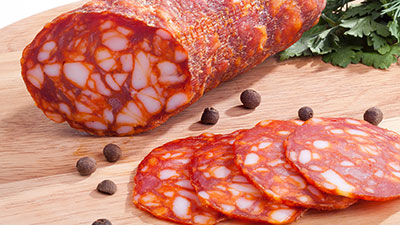Meats and Sausages
Chorizo Gallego
Chorizo Gallego is the most popular sausage in Galicia. The sausage is produced by commercial meat plants and hobbyists at home from quality meats: lean pork (70-80%) and back fat (20-30%). It is characterized by a dark red color and visible and generous distribution of fat pieces. Sausage is safe to eat after losing 30% of its original weight. Chorizo Gallego is consumed raw, fried, grilled or becomes an ingredient in many dishes.
| Meats | Metric | US |
|---|---|---|
| Pork, lean (shoulder or ham) | 700 g | 1.54 lb |
| Pork back fat, belly or fat trimmings | 300 g | 0.66 lb |
Ingredients per 1000g (1 kg) of meat
| Salt | 22 g | 3.5 tsp |
| Cure #1 | 2.5 g | 1 tsp |
| Pimentón, sweet | 20 g | 3.5 Tbsp |
| Pimentón, hot | 5.0 g | 2.5 tsp |
| Garlic | 7.0 g | 2 cloves |
Instructions
- Cut or grind meat and fat into 8 mm (3/8') pieces.
- Mix salt, cure #1 and spices together. Mix with meats.
- Hold for 24 hours in refrigerator.
- Stuff firmly into 36 mm pork casing forming 15 cm (6”) links.
- Smoke at 18° C (64° F) with oak wood for 12-48 hours.
- Dry at 12-15° C (53-5°9 F) for 30-45 days.
- Store in a dark place at 12° C or less, <65% humidity.
Notes
Chorizo Gallego was traditionally smoked in home chimneys.
The sausage was traditionally preserved by keeping it in oil or in lard.
The sausage can be consumed raw, cooked, fried or grilled, but is usually served with boiled potatoes and turnip greens, known in UK as rapini and in US as broccoli raab or broccoli rabe. It is also added to bean stew. There are local variants of the sausage, often onion is added (chorizo de cebolla or ceboleira), sometimes pumpkin (chorizo de calabaza).
The sausage was traditionally preserved by keeping it in oil or in lard.
The sausage can be consumed raw, cooked, fried or grilled, but is usually served with boiled potatoes and turnip greens, known in UK as rapini and in US as broccoli raab or broccoli rabe. It is also added to bean stew. There are local variants of the sausage, often onion is added (chorizo de cebolla or ceboleira), sometimes pumpkin (chorizo de calabaza).


















